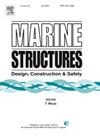Numerical analysis of extreme water slamming damage and residual strength of ring-stiffened columns of a semi-submersible floating offshore wind turbine
IF 5.1
2区 工程技术
Q1 ENGINEERING, CIVIL
引用次数: 0
Abstract
Foundation platforms of floating offshore wind turbines (FOWTs) must withstand harsh weather conditions, during which wave slamming is an important loading condition. Slamming is a complex dynamic problem involving fluid–structure interactions (FSI) but is often simplified as simple pressure loads neglecting the coupling effects during design. This paper examines the local structural response of a column of a FOWT floater during slamming, offering deeper understanding of impact dynamics and a measure of accuracy for design methods.
An initial benchmark study on numerical techniques of modeling FSI during water impact of a thin plate was conducted adopting three approaches, i.e. arbitrary Lagrangian–Eulerian (ALE), smoothed particle hydrodynamics (SPH) and incompressible computational fluid dynamics (ICFD). Subsequently, water impact on a ring stiffened cylindrical column of a FOWT floater was investigated using ALE simulations in a range of idealized impact conditions. The structural responses and impact pressures were analyzed, focusing on structural damage evolution. Simplified design methods for predictions of slamming damage were compared with the coupled FSI simulations, using four methods for generating design pressures. Finally, the residual bending strength of the damaged column was determined as an assessment of the consequences of slamming regarding structural integrity.
This paper provides insights into accuracy levels of different numerical techniques for FSI modeling and contributes to efficient design of offshore structures subjected to severe wave slamming.
海上半潜式浮式风力机环加筋柱极端水击损伤及残余强度数值分析
海上浮式风力发电机组的基础平台必须承受恶劣的天气条件,其中波浪冲击是一个重要的荷载条件。撞击是一个涉及流固耦合的复杂动力问题,但在设计中往往被简化为简单的压力载荷而忽略了耦合效应。本文研究了fot浮子柱在撞击过程中的局部结构响应,为设计方法的准确性提供了更深入的理解和测量。采用任意拉格朗日-欧拉(ALE)、光滑颗粒流体力学(SPH)和不可压缩计算流体力学(ICFD)三种方法,对薄板水冲击过程中FSI数值模拟技术进行了初步的基准研究。随后,在一系列理想冲击条件下,利用ALE模拟研究了水对FOWT浮子环加强型圆柱柱的冲击。分析了结构响应和冲击压力,重点分析了结构损伤演化。采用四种方法生成设计压力,将简化设计方法与耦合FSI模拟进行了比较。最后,确定了受损柱的残余抗弯强度,以评估撞击对结构完整性的影响。本文提供了不同的数值模拟技术的精度水平的见解,有助于有效地设计海上结构的严重冲击。
本文章由计算机程序翻译,如有差异,请以英文原文为准。
求助全文
约1分钟内获得全文
求助全文
来源期刊

Marine Structures
工程技术-工程:海洋
CiteScore
8.70
自引率
7.70%
发文量
157
审稿时长
6.4 months
期刊介绍:
This journal aims to provide a medium for presentation and discussion of the latest developments in research, design, fabrication and in-service experience relating to marine structures, i.e., all structures of steel, concrete, light alloy or composite construction having an interface with the sea, including ships, fixed and mobile offshore platforms, submarine and submersibles, pipelines, subsea systems for shallow and deep ocean operations and coastal structures such as piers.
 求助内容:
求助内容: 应助结果提醒方式:
应助结果提醒方式:


